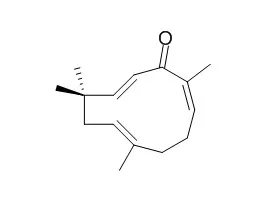| Animal Research: |
| Int J Mol Sci. 2019 Sep 14;20(18). pii: E4560. | | Zerumbone Suppresses Enterotoxigenic Bacteroides fragilis Infection-Induced Colonic Inflammation through Inhibition of NF-κΒ.[Pubmed: 31540059 ] | Enterotoxigenic Bacteroides fragilis (ETBF) is human intestinal commensal bacterium and a potent initiator of colitis through secretion of the metalloprotease Bacteroides fragilis toxin (BFT). BFT induces cleavage of E-cadherin in colon cells, which subsequently leads to NF-κB activation. Zerumbone is a key component of the Zingiber zerumbet (L.) Smith plant and can exhibit anti-bacterial and anti-inflammatory effects. However, whether Zerumbone has anti-inflammatory effects in ETBF-induced colitis remains unknown. The aim of this study was to determine the anti-inflammatory effect of orally administered Zerumbone in a murine model of ETBF infection.
METHODS AND RESULTS:
Wild-type C57BL/6 mice were infected with ETBF and orally administered Zerumbone (30 or 60 mg/kg) once a day for 7 days. Treatment of ETBF-infected mice with Zerumbone prevented weight loss and splenomegaly and reduced colonic inflammation with decreased macrophage infiltration. Zerumbone treatment significantly decreased expression of IL-17A, TNF-α, KC, and inducible nitric oxide synthase (iNOS) in colonic tissues of ETBF-infected mice. In addition, serum levels of KC and nitrite was also diminished. Zerumbone-treated ETBF-infected mice also showed decreased NF-κB signaling in the colon. HT29/C1 colonic epithelial cells treated with Zerumbone suppressed BFT-induced NF-κB signaling and IL-8 secretion. However, BFT-mediated E-cadherin cleavage was unaffected. Furthermore, Zerumbone did not affect ETBF colonization in mice.
CONCLUSIONS:
In conclusion, Zerumbone decreased ETBF-induced colitis through inhibition of NF-κB signaling. | | Int Immunopharmacol. 2019 Aug;73:552-559. | | Zerumbone from Zingiber zerumbet inhibits innate and adaptive immune responses in Balb/C mice.[Pubmed: 31177081] | Zerumbone exhibited various biological properties including in vitro immunosuppressive effects. However, its modulatory activity on the immune responses in experimental animal model is largely unknown.
METHODS AND RESULTS:
This investigation was conducted to explore the effects of daily treatment of Zerumbone (25, 50, and 100 mg/kg) isolated from Zingiber zerumbet rhizomes for 14 days on various cellular and humoral immune responses in Balb/C mice. For measurement of adaptive immunity, sheep red blood cells (sRBC) were used to immunize the mice on day 0 and orally fed with similar doses of Zerumbone for 14 days. The effects of Zerumbone on phagocytosis, nitric oxide (NO) release, myeloperoxidase (MPO) activity, proliferation of T and B cells, lymphocyte phenotyping, cytokines release in serum by activated T cells, delayed type hypersensitivity (DTH) and immunoglobulins production (IgG and IgM) were investigated. Zerumbone downregulated the engulfment of E. coli by peritoneal macrophages and the release of NO and MPO in a concentration-dependent manner. Zerumbone showed significant and concentration-dependent suppression of T and B lymphocytes proliferation and inhibition of the Th1 and Th2 cytokines release. At higher concentrations of Zerumbone, the % expression of CD4+ and CD8+ in splenocytes was significantly inhibited. Zerumbone also concentration-dependently demonstrated strong suppression on sRBC-triggered swelling of mice paw in DTH. Substantial suppression of anti-sRBC immunoglobulins antibody titer was noted in immunized and Zerumbone-treated mice in a concentration-dependent manner.
CONCLUSIONS:
The potent suppressive effects of Zerumbone on the immune responses suggest that Zerumbone can be a potential candidate for development of immunosuppressive agent. | | Molecules. 2019 May 22;24(10). pii: E1964. | | Zerumbone Protects against Carbon Tetrachloride (CCl4)-Induced Acute Liver Injury in Mice via Inhibiting Oxidative Stress and the Inflammatory Response: Involving the TLR4/NF-κB/COX-2 Pathway.[Pubmed: 31121820 ] | The natural compound Zerumbone (hereinafter referred to as ZER), a monocyclic sesquiterpenoid, has been reported to possess many pharmacological properties, including antioxidant and anti-inflammatory properties. This study aimed to investigate the underlying mechanism of ZER against acute liver injury (ALI) in CCl4-induced mice models.
METHODS AND RESULTS:
ICR mice were pretreated intraperitoneally with ZER for five days, then received a CCl4 injection two hours after the last ZER administration and were sacrificed 24 h later. Examination of serum aspartate aminotransferase (AST) and alanine aminotransferase (ALT) activities and the histopathological analysis confirmed the hepatoprotective effect of ZER. Biochemical assays revealed that ZER pretreatment recovered the activities of antioxidant enzymes superoxide dismutase (SOD) and glutathione peroxidase (GSH-Px), restored the glutathione (GSH) reservoir, and reduced the production of malondialdehyde (MDA), all in a dose-dependent manner. Furthermore, administration of ZER in vivo reduced the release amounts of pro-inflammatory cytokines interleukin-6 (IL-6) and tumor necrosis factor alpha (TNF-α) and inhibited the increased protein levels of Toll-like receptor 4 (TLR4), nuclear factor-kappaB (NF-κB) p-p65, and cyclooxygenase (COX-2). Further studies in lipopolysaccharide (LPS)-induced Raw264.7 inflammatory cellular models verified that ZER could inhibit inflammation via inactivating the TLR4/NF-κB/COX-2 pathway.
CONCLUSIONS:
Thus, our study indicated that ZER exhibited a hepatoprotective effect against ALI through its antioxidant and anti-inflammatory activities and the possible mechanism might be mediated by the TLR4/NF-κB/COX-2 pathway. Collectively, our studies indicate ZER could be a potential candidate for chemical liver injury treatment. |
|






 Cell. 2018 Jan 11;172(1-2):249-261.e12. doi: 10.1016/j.cell.2017.12.019.IF=36.216(2019)
Cell. 2018 Jan 11;172(1-2):249-261.e12. doi: 10.1016/j.cell.2017.12.019.IF=36.216(2019) Cell Metab. 2020 Mar 3;31(3):534-548.e5. doi: 10.1016/j.cmet.2020.01.002.IF=22.415(2019)
Cell Metab. 2020 Mar 3;31(3):534-548.e5. doi: 10.1016/j.cmet.2020.01.002.IF=22.415(2019) Mol Cell. 2017 Nov 16;68(4):673-685.e6. doi: 10.1016/j.molcel.2017.10.022.IF=14.548(2019)
Mol Cell. 2017 Nov 16;68(4):673-685.e6. doi: 10.1016/j.molcel.2017.10.022.IF=14.548(2019)